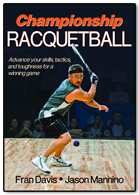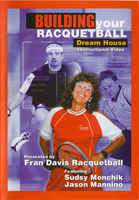 In the last Newsletter I talked about FEAR and where it comes from and how to deal with it. (Click HERE to read part one) In this issue my team of experts and I want to teach you the techniques you can use to “Overcoming Fear.” It comes from lots of hard work in every aspect of the Sports Racquetball Triangle. It is not by accident Rocky has been the #2 IRT Player, Paola has been the #1 or #2 WPRO Player for the last several years, and Taylor and Sharon are marching up the Pro Ranks….let’s take a look:
In the last Newsletter I talked about FEAR and where it comes from and how to deal with it. (Click HERE to read part one) In this issue my team of experts and I want to teach you the techniques you can use to “Overcoming Fear.” It comes from lots of hard work in every aspect of the Sports Racquetball Triangle. It is not by accident Rocky has been the #2 IRT Player, Paola has been the #1 or #2 WPRO Player for the last several years, and Taylor and Sharon are marching up the Pro Ranks….let’s take a look:
The Sports Racquetball Triangle: Conditioning, Mental, and Physical Skills
Left Side of the Triangle
Conditioning
Before you can begin to delve into speed, agility, power and strength, balance, and flexibility, it’s imperative that you know the fundamentals of movement (by our Fitness Expert, Dan O’Bremski)—in other words, how your body parts influence your efficiency and speed of movement. Just think of it in terms of your racquetball game. If I were to teach you the strategy of the game, what serves to use, and the ceiling shot without showing you the proper stroke mechanics of the forehand and backhand, I would be setting you up to be very frustrated, and you would probably not achieve the success that you could if you were fundamentally sound with good mechanics. It is the same philosophy for all the conditioning skills; they must be performed with correct form in order to get the most benefit from them.
Fundamentals of Movement
Dorsiflexion of the Feet
Dorsiflexion is an anatomical term that means having the toes or foot curled up. This movement is the foundation of all racquetball movement skills because it gets you on the balls of your feet.
Hip Drive
Downward hip drive is produced by lifting the knee to hip level, with dorsiflexion of the toes, and then applying force down into the ground under your center of mass (COM). This downward application of force produces forward speed.
Arm Drive
Using the arms properly has a huge impact on your running speed and efficiency. Proper arm drive is produced by keeping the elbows at 90 degrees, with your hands relaxed. The proper range of motion for sprinting is to have your hands flow from chin level to hip level, with an emphasis on backward elbow drive
Posture
Proper posture for an athlete is having the shoulders lined up with the ears. Having proper posture allows you to move your arms in the right fashion and will definitely help with all your racquetball strokes.
Head Placement
Many athletes drop their heads when running, which weakens their posture and prevents them from using their arms properly. A good tip to remember is to keep your head up in all running drills and your eyes on the ball when playing racquetball.
The above fundamentals of movement for racquetball should be adhered to when performing the speed, agility, power/strength, balance and flexibility drills outlined in my book, “Championship Racquetball.”
Nutrition
Dehydration
Our Nutritional Expert, Diana McNab, informs us that the primary nutritional cause of poor racquetball performance over prolonged matches is usually dehydration. During exercise, plasma (blood) volume decreases as a consequence of both an increase in sweating and a net movement of water away from the blood vessels.
During a racquetball match you need to remain hydrated. Racquetball athletes should follow this formula for the amount of liquids they should consume.
ONE HALF Of BODY WEIGHT = OUNCES OF LIQUID
An athlete needs one half of his/her body weight, in ounces, of water to maintain performance. So, a 175-pound athlete would need 87 ounces of Liquid or 8 to 10 glasses during a match.
Right Side of the Triangle
Mental Skills
Play in the Now
In sport psychology, our Mental Toughness Expert Diana McNab, tells us there is only one time, and it is now. When are you going to start to focus? Now! When are you going to win your serve? Now! When are you going to start to play well? Now!
In sports the past is gone and the future never comes, so in racquetball you have to learn that there is only one ball, one shot, one serve, and one point at a time, and that time is always now. That is truly the real beauty—that every shot you hit only happens in the now.
The only problem is that your ego wants to hold onto your past mistakes and FEAR the future. It always wants to be right and take control of the situation. The beauty of totally playing in the moment is that there is no ego and you are 100 percent connected to the ball, the wall, the shot, or the point. Playing in the now erases the ego because your mind can hold only one thought in your head at a time, so focusing on the moment erases all past or future ego thoughts. Do not dwell on the past or worry about the future because that only feeds the ego.
*Check my book, “Championship Racquetball” to learn all about this:
How to Get In the Now
How to Get Out of the Now
On-Court Rituals to Bring Your Mind and Body Back to the Now
Base of the Triangle
Physical Skills
Video analysis is the ideal way to watch yourself and/or your opponent in a match because you can watch the video leisurely as many times as you like to obtain as much information as possible that you might miss with the naked eye. I have watched hours upon hours of video with all my students from Rocky, to Paola, to Jason, to Taylor and to Sharon. I craft a drilling session to sharpen their games based on what we learn from video analysis. I also use it at all of my camps and in my lessons. It is the MOST powerful tool to pick up all the strengths and weakness in your and your opponents’ games.
Rocky’s and Paola’s “Championship Racquetball Game” stems from ALL 3 sides of the triangle being present and working together so they can develop . Without a shadow of a doubt they KNOW just how important it is to do the work. They are living proof it works and their titles substantiate it.
Next issue I will continue to build your Championship Racquetball Game one level at a time so you too can be ready to become the champion you always dreamed of, but now you will have the tools to do it and make it a reality.
*Check my book, “Championship Racquetball” to learn all about utilizing Video Analysis and the Game Evaluation Sheet to depict your Physical Skill weaknesses. For details on more personalized instruction, a weekend camp, instructional DVD’s, our book, “Championship Racquetball,” and more, please visit www.FranDavisRacquetball.com.
Fran Davis is a 2004 racquetball Hall of Fame inductee, Racquetball Woman of the Year 2009, Coach #2 IRT Pro Player, Rocky Carson; Coach #1 Women’s Pro Player, Paola Longoria; Coach Jr. World & National Champion, Intercollegiate Champion, & #18 IRT Pro Player, Taylor Knoth; Coach Intercollegiate Champion & #25 WPRO Pro Player, Sharon Jackson; Master Professional Instructor/Coach USAR-IP. International Racquetball Tour.










